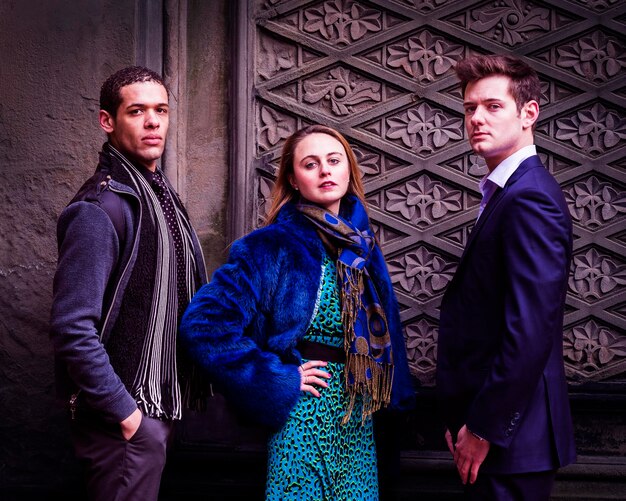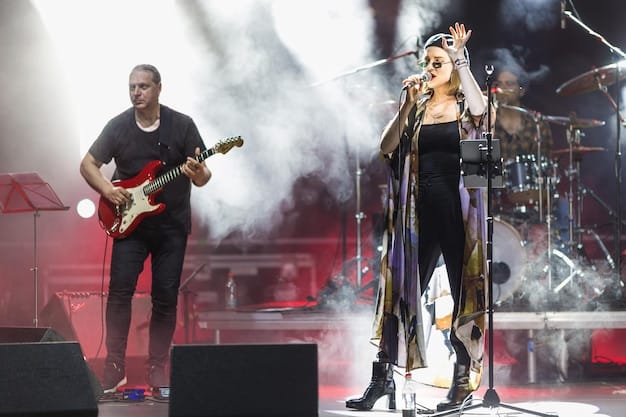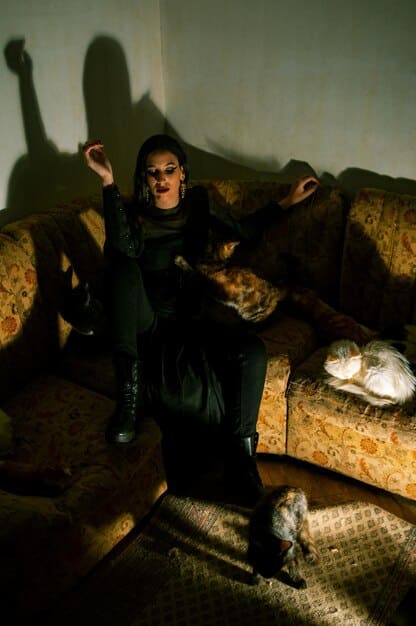Goth Subculture in the US: Music, Fashion & Philosophy in 2025

The Goth subculture in the US, characterized by unique music, fashion, and philosophical perspectives, continues to evolve, with projections for 2025 indicating shifts in its identity and influence.
The Goth subculture in the US: Exploring the Evolution of Music, Fashion, and Philosophy in 2025 promises to be as captivating and multifaceted as ever, shaped by technological advancements, social trends, and the enduring allure of its dark romanticism.
Understanding the Goth Subculture: An Introduction
The Goth subculture is a diverse and complex phenomenon that has evolved significantly since its emergence in the late 1970s. Rooted in post-punk music and a fascination with the darker aspects of art and literature, the subculture has developed its own distinctive aesthetic and philosophical outlook.
Understanding the Goth subculture requires appreciating its historical context, its key influences, and its ongoing transformations. We delve into the defining elements of the Goth subculture, exploring its music, fashion, and philosophical underpinnings.
Origins and Influences
The Goth subculture emerged from the post-punk scene in the late 1970s and early 1980s, with bands like Bauhaus, Siouxsie and the Banshees, and The Cure laying the musical groundwork. Influenced by Romantic literature, Victorian aesthetics, and horror films, the subculture developed a unique identity characterized by dark fashion, introspective lyrics, and a fascination with the macabre.
- Music: Post-punk, darkwave, and ethereal wave are key genres.
- Fashion: Black clothing, lace, corsets, and dramatic makeup are common.
- Philosophy: Existentialism, Romanticism, and a celebration of individuality are central themes.
The Goth subculture has always been a space for those who feel marginalized or misunderstood, offering a sense of community and belonging to individuals who embrace its unique aesthetic and values. As we move into 2025, it’s essential to understand how these foundational elements continue to shape the subculture.
The Evolution of Goth Music in the US
Music has always been a cornerstone of the Goth subculture, serving as a unifying force and a means of self-expression. The evolution of Goth music in the US reflects broader trends in the music industry and the changing tastes of its adherents.
The evolution of Goth music in the US continues to progress by hybridizing it with unexpected genres and sub genres. Investigating Goth music involves exploring new sounds, artists, and platforms that are shaping the future of the subculture.
Emerging Artists and Sounds
In the US, a new wave of Goth artists is emerging, blending traditional Goth sounds with elements of electronic music, industrial, and even hip-hop. These artists are pushing the boundaries of the genre and attracting a wider audience to the subculture. Some notable trends include:
- Darkwave Revival: A resurgence of interest in the melancholic and atmospheric sounds of darkwave.
- Industrial Fusion: Incorporating harsh electronic beats and distorted sounds into Goth compositions.
- Goth-Pop Hybrids: Blending Goth aesthetics with pop sensibilities to create catchy and accessible tracks.

Looking to the future, the Goth music scene in the US is posed for continued growth and innovation. New artists, sounds, and platforms are emerging, ensuring that Goth music remains a vital and evolving part of the subculture.
Goth Fashion: Trends and Transformations in 2025
Fashion is a visual expression of the Goth subculture, reflecting its dark romanticism and individuality. Over the years, Goth fashion has evolved, incorporating diverse influences and adapting to changing social norms.
In 2025, Goth fashion trends in the US are expected to undergo further transformations, influenced by technology, sustainability, and a renewed emphasis on self-expression. An important part of understanding that transformation involves exploring the fusion of traditional elements with new materials and styles.
Sustainability and Ethical Fashion
With growing awareness of environmental issues, sustainability is becoming an increasingly important factor in Goth fashion. Designers are exploring eco-friendly materials and ethical production practices to create clothing that aligns with the subculture’s values.
Goth fashion is evolving and now emphasizes sustainability, ethical production, and inclusivity.
- Eco-Friendly Materials: Using organic cotton, recycled fabrics, and vegan leather alternatives.
- Upcycling and DIY: Creating unique pieces from repurposed clothing and materials.
- Ethical Production: Supporting brands that prioritize fair labor practices and transparent supply chains.
In 2025, Goth fashion is poised to become more inclusive, sustainable, and expressive. These transformations reflect the subculture’s ongoing evolution and its commitment to individuality and creativity.
The Philosophical Underpinnings of Goth Culture
Beyond the music and fashion, the Goth subculture is underpinned by a unique philosophical outlook. This outlook encompasses themes of existentialism, Romanticism, and a celebration of individuality.
In the US, the philosophical underpinnings of Goth culture are being re-evaluated in light of contemporary social and political issues. That investigation is a matter of exploring the ways in which Goth thought intersects with modern concerns.
Existentialism and Romanticism
Existentialism is concerned with questions of existence, meaning, and the individual’s freedom and responsibility. Romanticism emphasizes emotion, imagination, and the beauty of the natural world. These philosophical traditions resonate deeply with the Goth subculture, which often grapples with themes of alienation, mortality, and the search for meaning.
Existentialism and Romanticism guide the Goth subculture’s appreciation for emotion, imagination, and existential questions.
- Existential Themes: Exploring the meaning of life, the nature of existence, and the individual’s place in the universe.
- Romantic Ideals: Celebrating beauty, emotion, and the power of imagination.
- Individuality and Nonconformity: Embracing uniqueness and rejecting societal norms.
These philosophical underpinnings continue to shape the Goth subculture in the US, providing a framework for self-expression, community, and personal growth.
Goth Subculture and Technology: 2025 and Beyond
Technology is an increasingly integral part of modern life, and the Goth subculture is no exception. Social media, online communities, and digital art are shaping the way Goths connect, create, and express themselves.
In 2025, technology is anticipated to play an even more significant role in the Goth subculture in the US, influencing its music, fashion, and social dynamics.

Online Communities and Social Media
Online communities and social media platforms are vital spaces for Goths to connect with one another, share their creations, and find support. Platforms like Tumblr, Instagram, and TikTok have become hubs for Goth fashion, music, and art.
This subculture thrives on virtual spaces where they can connect, share art, and express themselves. By promoting inclusivity and creativity, the online landscape reshapes the community’s structure.
As the Goth subculture continues to evolve in the digital age, it’s essential to recognize the power of technology to connect, inspire, and empower its adherents.
The Future of Goth in the US: 2025 and Beyond
Looking ahead, the Goth subculture in the US is poised for continued growth and transformation. As the subculture adapts to changing social and technological landscapes, it will likely retain its core values while embracing new forms of expression.
The future of Goth in the US depends on various trends and influences, exploring future developments, challenges, and opportunities for the subculture is part of understanding its evolution.
Challenges and Opportunities
The Goth subculture faces several challenges in the coming years, including mainstreaming, cultural appropriation, and the potential for misrepresentation. However, it also has opportunities to promote inclusivity, diversity, and social awareness.
- Mainstreaming Concerns: Preserving the subculture’s unique identity in the face of growing popularity.
- Cultural Appropriation: Ensuring that non-Goths respect and appreciate the subculture’s history and values.
- Promoting Inclusivity: Creating a welcoming and supportive environment for individuals of all backgrounds and identities.
The future of the Goth subculture lies in its ability to adapt, innovate, and remain true to its core values. As it navigates the challenges and opportunities ahead, the subculture will continue to evolve and inspire those who embrace its dark romanticism and individuality.
| Key Aspect | Brief Description |
|---|---|
| 🦇 Music | Evolving genres blending darkwave, industrial, and pop elements. |
| 🖤 Fashion | Sustainable and ethical trends using eco-friendly materials. |
| 💀 Philosophy | Existential and Romantic themes emphasizing individuality. |
| 🕸️ Technology | Online communities and digital art shaping the Goth identity. |
Frequently Asked Questions
▼
The Goth subculture emerged from the post-punk scene in the late 1970s and early 1980s, influenced by bands like Bauhaus and Siouxsie and the Banshees.
▼
Goth fashion typically includes black clothing, lace, corsets, and dramatic makeup, often drawing inspiration from Victorian and Romantic aesthetics.
▼
Technology plays a significant role through online communities and social media, enabling Goths to connect, share art, and express themselves virtually.
▼
Central philosophical themes include existentialism and Romanticism, emphasizing individuality, emotion, and the exploration of life’s deeper meanings.
▼
The Goth subculture in the US is evolving by incorporating sustainable practices, blending musical genres, and promoting inclusivity across various platforms.
Conclusion
The Goth subculture in the US: Exploring the Evolution of Music, Fashion, and Philosophy in 2025 highlights the subculture’s enduring appeal and adaptability. From its musical roots to its philosophical underpinnings, the Goth subculture continues to evolve, embracing technology and promoting inclusivity while staying true to its unique identity. As it moves forward, the Goth subculture promises to remain a vibrant and influential force in the cultural landscape of the United States.





